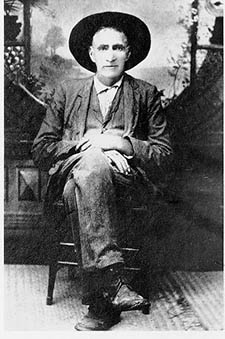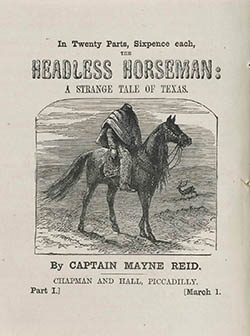Dark and stormy nights at the Capitol might be the perfect time to become acquainted with some Capitol spirits. Will you see Comptroller Love walking the hallways near the office where he was shot and killed in 1903? Or, will Governor Edmund Davis (1870-1874) tip his hat to you as you walk by him? Stroll across the street to the Governor's Mansion and you might find Sam Houston, standing by his famous four-poster mahogany bed in the bedroom bearing his name.
Have you ever heard of the Headless Horseman? Most people are familiar with "The Legend of Sleepy Hollow," an 1820 short story written by Washington Irving. Did you know that Texas has its own Headless Horseman legend?
For the past several years around Halloween, we've shared ghostly stories related to Texas. (See our previous posts from 2016, 2017, 2018, and 2019.) Below, you'll find more information about Texas' Headless Horseman.
Texas' Headless Horseman
Have you driven the roads south and west of San Antonio late at night? Did you see El Muerto, the Headless One?
- "The big mustang drank . . . Gaunt in the thin moon, his rider waited, leaning on his saddlehorn with all the patience of death . . . Even the faint light showed the stump above his shoulders; his head — its sombrero still secured — was a restless pendulum, swinging gently . . . El Muerto was gone at a gallop, his head bouncing against his thigh" (William Edwards Syers, Ghost Stories of Texas [Waco, TX: Texian Press, 1981]).
 |
| William A. A. "Bigfoot" Wallace. Courtesy of the Texas State Cemetery. |
William A. A. "Bigfoot" Wallace was at the heart of many an interesting Texas tale, so it's no surprise that he's an integral part of the headless horseman story. Bigfoot and friends caught up with the horse thief, Vidal, in the land below Uvalde. According to legend, as a warning to other thieves, Wallace decapitated Vidal, mounted him on a mustang, and strapped his sombreroed head to the saddle horn. In the words of J. Frank Dobie, the mustang "broke away into a run that, as we have seen, scared up a legend not yet dead" (J. Frank Dobie, "The Headless Horseman of the Mustangs," in Tales of Old-Time Texas [Austin: University of Texas Press, [1984]]).
 |
| Chapman and Hall, The Headless Horseman: A Strange Tale of Texas by Captain Mayne Reid, advertisement. In Part 11 of Our Mutual Friend, Charles Dickens. London: Chapman and Hall, March 1865. https://digitalcommons.wpi.edu/ourmutualfriend/11/. |
Many authors have given their take on this story. One of the earliest was by Mayne Reid in his 1865 novel, The Headless Horseman: A Strange Tale of Texas. And what role did Creed Taylor play in spreading the tale? He was a larger-than-life character, participating in many pivotal events in Texas history. Was he along on the chase for the horse thief Vidal with Bigfoot Wallace? If not, he was perhaps the first to relate the story of the thief's decapitation and the origin of the big mustang with the headless rider that terrified South Texas. Did he "stretch the blanket" when telling his stories? Find more details in Lou Ann Herda's article, "The Evolution of a Legend: The Headless Horseman of Texas, or It May Not Be True, but It Makes a Good Story," in Both Sides of the Border: A Scattering of Texas Folklore.
Check out more stories on our Capitol Spirits Pinterest board.
From the Legislative Reference Library, we hope you have a fun and safe Halloween!!
Cover image by Daniel Mingus

